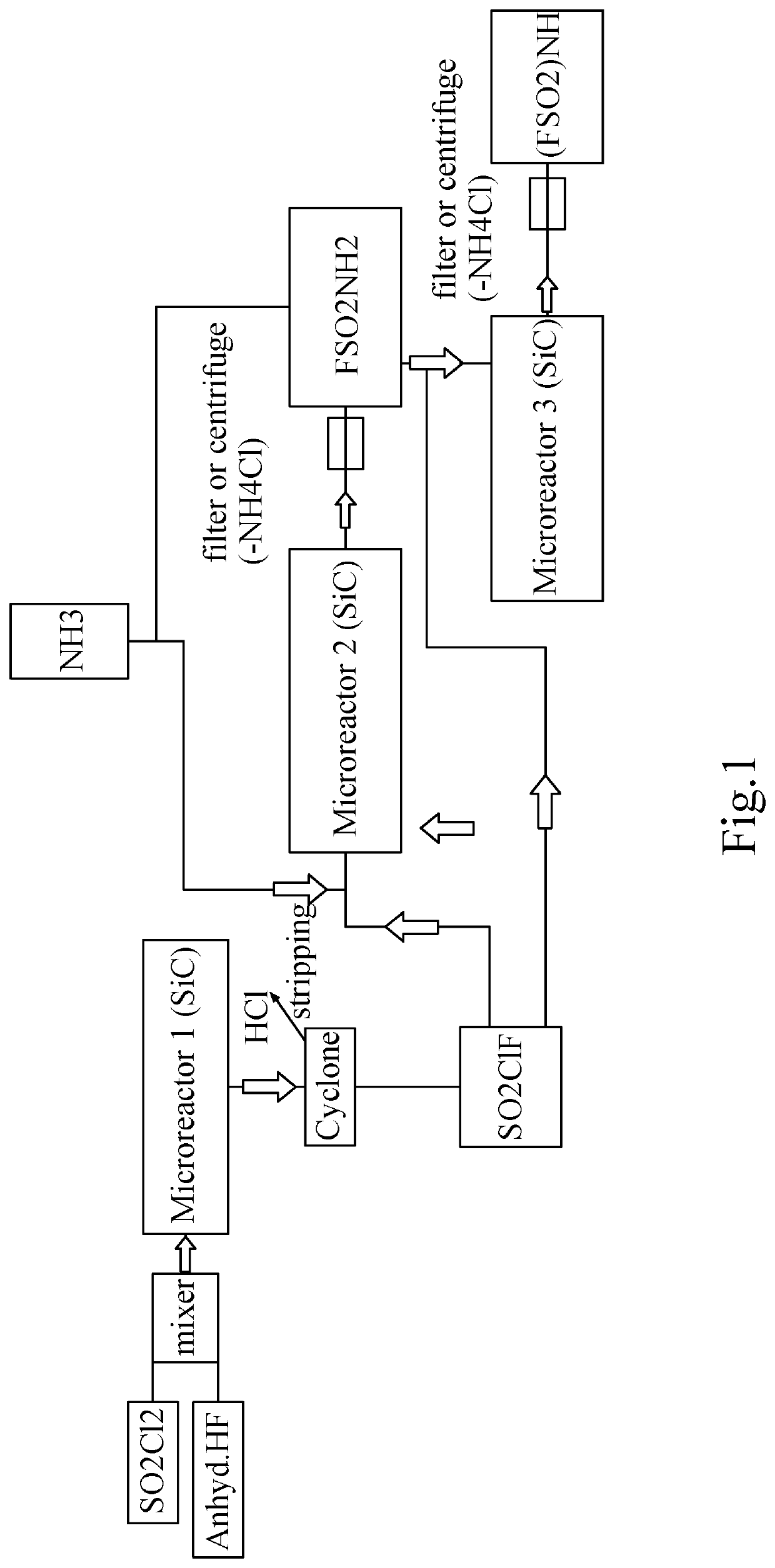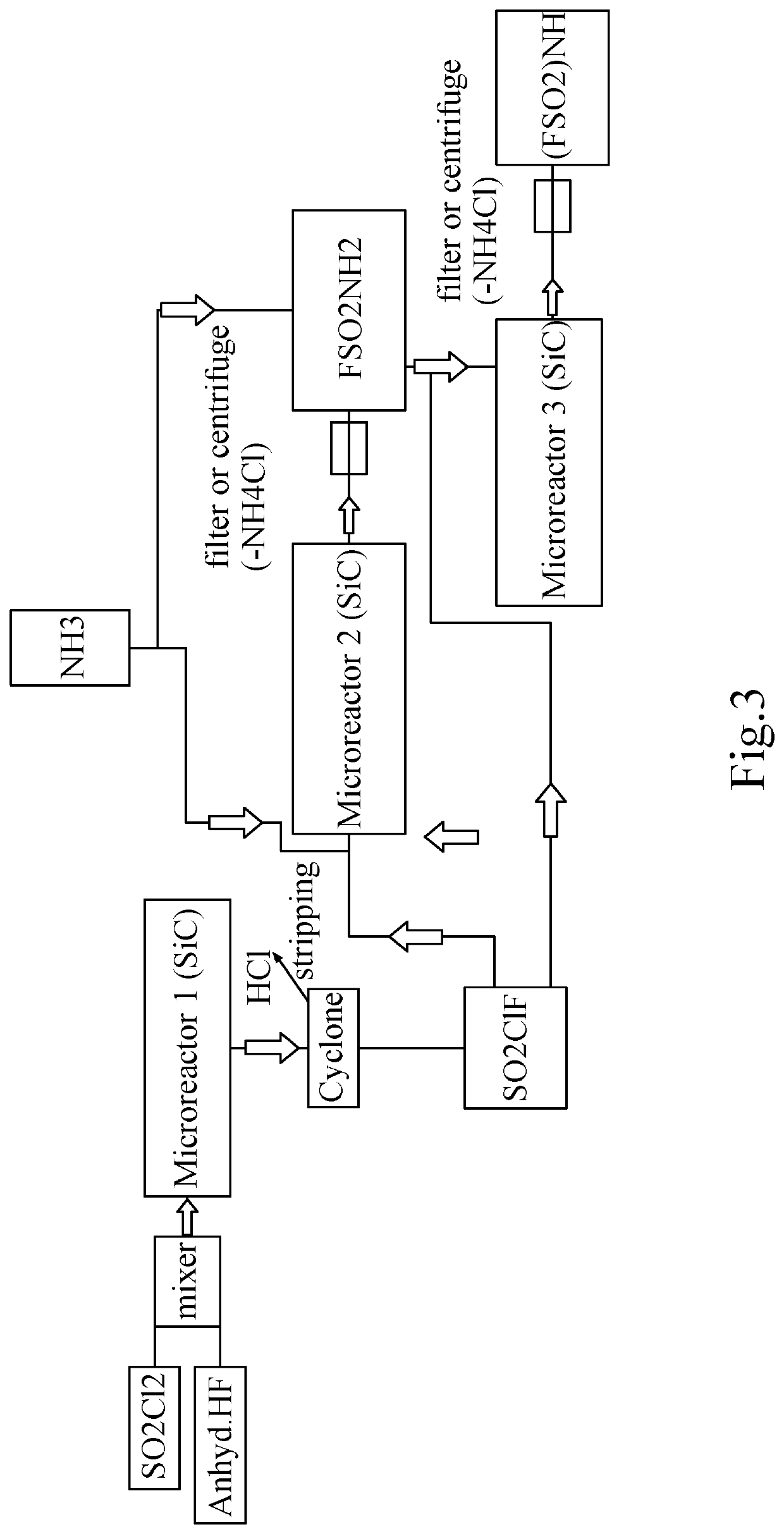Process for the Synthesis of Fluorinated Conductive Salts for Lithium Ion Batteries
a technology of lithium ion batteries and conductive salts, which is applied in the field of lithium ion battery fluorinated conductive salt synthesis, can solve the problems of difficulty in fluorination, published synthesis methods, and no economic synthesis, and achieves the effect of reducing and simplifying avoiding time and energy consumption, and reducing the number of separation steps
- Summary
- Abstract
- Description
- Claims
- Application Information
AI Technical Summary
Benefits of technology
Problems solved by technology
Method used
Image
Examples
example 1
[0186]Synthesis of SO2ClF without catalyst and without any presence of a fluorinating agent.
[0187]SO2ClF is synthesized in batch by adding HF (anhydreous) into SO2Cl2, e.g., in a Roth autoclave with HDPTFE Inliner, 1 deep pipe and one outlet at gas phase (pressure kept at 10 bar) at room temperature (without any catalyst under evolvement of HCl or continuously in a microreactor system). So 110 g (0.82 mol) Sulfurylchlorid is filled into a 250 ml Autoclave (company Roth) having a HPTFE Inliner, after closing of the autoclave, 82.1 g (4.1 mol) anhydrous HF was added from a N2 pressurized Cylinder from the liquid phase over the deep pipe into the autoclave. The autoclave is then slowly heated to 50° C. with an oil bath (pressure kept at 10 bar) and formed HCl is let escape into a scrubber over a pressure valve.
[0188]After 99.9% of the HCl has left the autoclave (calculated by analysis of Chloride in the scrubber), the remaining content (which is almost 100% SO2ClF+HF) is transferred in...
example 2
[0189]Conversion of SO2ClF to FSO2NH2.
[0190]To the autoclave content which was 90 g (0.77 mol) as prepared under example 1, 32.4 g (1.9 mol) NH3 is now fed into the autoclave. The mixture is let to warm up and the reaction is finalized by keeping further 3 h at 50° C. The autoclave is cooled to room temperature, remaining pressure released into a scrubber and afterwards, the formed Ammoniumchloride is filtered off the formed Fluorosulfonylamide to get finally a yellow to brownisch liquid which is FSO2NH2 (97% purity (GC)).
[0191]Remark: As SO2ClF is much more reactive than SO2Cl2, the conversion to the isocyanate by using hazardous chemicals like in other literature references can be avoided and saved.
example 3
[0192]Conversion of FSO2NH2 to FSO2NHSO2F.
[0193]In the next step, added to the Fluorosulfonamide of example 2, is a 1.01 stöchiometric amount of another ClSO2F (prepared according to example 1) followed by a 1.01 stöchiometric amount of NH3 which is kept together at 50° C. for 2 h. After cooling down and expanding to atmospheric pressure, the formed NH4Cl is filtered off again. A brown solid is isolated which is characterized as Bis-Fluorosulfonylimide. Other easier than NH3 to handle bases like NEt3, DBN, DBU, DMAP, Pyridine are also possible or could be added as accelerator but this alternatives are more difficult to be separated from the product.
PUM
| Property | Measurement | Unit |
|---|---|---|
| residence time | aaaaa | aaaaa |
| flow rate | aaaaa | aaaaa |
| temperature | aaaaa | aaaaa |
Abstract
Description
Claims
Application Information
 Login to View More
Login to View More - R&D
- Intellectual Property
- Life Sciences
- Materials
- Tech Scout
- Unparalleled Data Quality
- Higher Quality Content
- 60% Fewer Hallucinations
Browse by: Latest US Patents, China's latest patents, Technical Efficacy Thesaurus, Application Domain, Technology Topic, Popular Technical Reports.
© 2025 PatSnap. All rights reserved.Legal|Privacy policy|Modern Slavery Act Transparency Statement|Sitemap|About US| Contact US: help@patsnap.com



